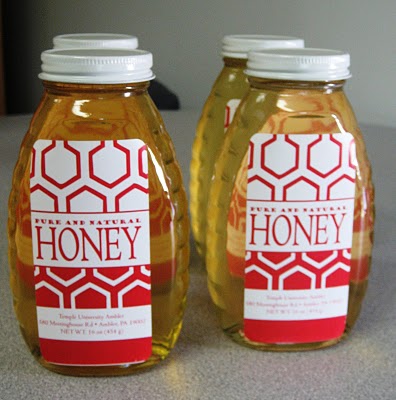Honey: The Business of Bees
by Lynn Kirk, Public Relations Writer, Lewis Ginter Botanical Garden, reprinted with permission from the Richmond Times-Dispatch

Honey Jar — label designed by Kristen Brown. The taste, color and fragrance of honey vary according to the nectar preference of honeybees.
“Sweet and aromatic with complex undertones.” Sound like a description of fine wine? Attributes like these can also apply to another of nature’s delectable byproducts: honey. In the U.S., honey is available in more than 300 distinct flavors, plus countless blends. The reason is that the sole producer – the honey bee – seems to enjoy variety as much as we do. Flower blossoms are honey bees’ main nectar source, and their preferences determine the resulting honey’s flavor profile. Flower-filled meadows, gardens teeming with flowering crops and some flowering trees are like honey-bee buffets, offering countless nectar options. And since flowering plants vary from region to region, so does the flavor of honey. While bees in zone 7 may prefer nectar from clover or wildflower blossoms, bees in other parts of the country may forage for nectar among eucalyptus, alfalfa and sage blossoms.
The plant source also influences the color of honey that’s produced. Typically, light-colored honeys are mild in flavor and dark varieties are more robust. As for aroma, take a few whiffs and you’ll discover that fragrance varies along with color and taste. Some scents are earthy, others floral, and occasionally by smell alone you can detect the honeybees’ plant source.
It’s the job of the honey bee workers to seek and find nectar. They may travel miles foraging for nectar treats, which they gather and bring back to their hive. In simple terms, the concentrated nectar is then regurgitated (yes, honey is a form of bee vomit), and the honey-making process continues with skilled assistance from other bees. Surplus honey is stored in the honeycomb, which is produced by female bees using wax excreted from their abdominal glands. The required labor is astonishing. According to the National Honey Board, as many as 60,000 bees in a beehive may collectively travel 55,000 miles and visit more than two million flowers over their lifetimes to gather enough nectar to make just a pound of honey!
Honey has been valued since ancient times. Raw honey is not only tasty; it’s natural, organic and nutritious (though not recommended for infants). Honey’s high sugar content extends its shelf-life indefinitely, as long as it’s stored in a tightly closed container away from direct sunlight, heat and refrigeration.
Editor’s Note: This article first published in the Richmond Times-Dispatch, in March 2011.